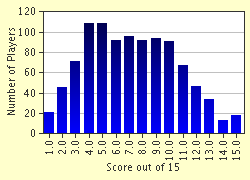Quiz Answer Key and Fun Facts
1. Who, with the help of his followers, made the first complete translation of the New Testament into English?
2. In 1536, this English Bible translator was put to death. His translation of the New Testament was based on Erasmus's Greek translation, with reference to the Vulgate.
3. What English Bible translation, also known as "Cromwell's Bible," was the first English Bible authorized for public use in churches?
4. Which Bible was the only English New Testament translation to be published during the reign of Mary Tudor, and also the first to be divided into verses?
5. In general, committees are not known either for their efficiency or their artistry. But what Bible did a committee produce, which proved to be a major source of literary inspiration for centuries to come?
6. What 20th century, Catholic Monsignor translated the Bible from the Latin Vulgate?
7. What Bible translation gave rise to controversy because of its insistence on gender neutral language and because of the theological implications of some of its word choices?
8. What was the first complete, English, Catholic Bible translation made from the original languages?
9. What modern English translation, made by Evangelicals (from America, Canada, England, Australia, and New Zealand) and relying directly on the original languages, was finally completed after some two decades of preliminary study?
10. Which of the following is not really a Bible "translation," but rather a "paraphrase"?
11. "Therefore the Lord himself shall give you a sign; Behold, a virgin shall conceive, and bear a son, and shall call his name Immanuel." From which translation does this quotation come?
12. "Therefore the Lord himself will give you a sign. Look, the young woman is with child and shall bear a son, and shall name him Immanuel." From which version does this quotation come?
13. "And Jesus went out, and saw much people, and had ruth on them, for they were as sheep not having a shepherd." From which version does this quotation come?
14. Some versions attempt word for word translations, others strive to be more idiomatic and to translate thought for thought. Of the following, which is most nearly a word for word translation?
15. According to Zondervan, of the following translations, which requires the lowest reading level to understand?
Source: Author
skylarb
This quiz was reviewed by FunTrivia editor
gtho4 before going online.
Any errors found in FunTrivia content are routinely corrected through our feedback system.

